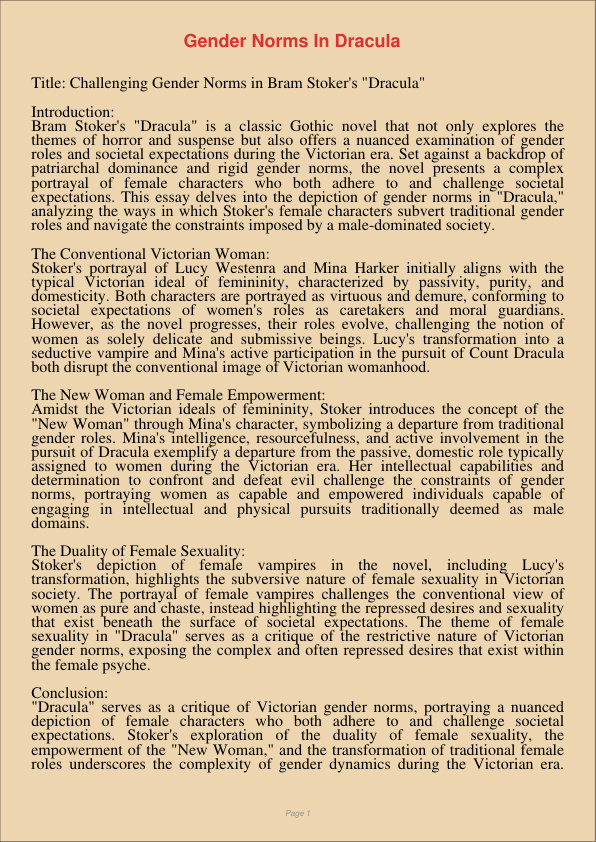
Title: Challenging Gender Norms in Bram Stoker’s “Dracula”
Introduction: Bram Stoker’s “Dracula” is a classic Gothic novel that not only explores the themes of horror and suspense but also offers a nuanced examination of gender roles and societal expectations during the Victorian era. Set against a backdrop of patriarchal dominance and rigid gender norms, the novel presents a complex portrayal of female characters who both adhere to and challenge societal expectations. This essay delves into the depiction of gender norms in “Dracula,” analyzing the ways in which Stoker’s female characters subvert traditional gender roles and navigate the constraints imposed by a male-dominated society.
The Conventional Victorian Woman: Stoker’s portrayal of Lucy Westenra and Mina Harker initially aligns with the typical Victorian ideal of femininity, characterized by passivity, purity, and domesticity. Both characters are portrayed as virtuous and demure, conforming to societal expectations of women’s roles as caretakers and moral guardians. However, as the novel progresses, their roles evolve, challenging the notion of women as solely delicate and submissive beings. Lucy’s transformation into a seductive vampire and Mina’s active participation in the pursuit of Count Dracula both disrupt the conventional image of Victorian womanhood.
The New Woman and Female Empowerment: Amidst the Victorian ideals of femininity, Stoker introduces the concept of the “New Woman” through Mina’s character, symbolizing a departure from traditional gender roles. Mina’s intelligence, resourcefulness, and active involvement in the pursuit of Dracula exemplify a departure from the passive, domestic role typically assigned to women during the Victorian era. Her intellectual capabilities and determination to confront and defeat evil challenge the constraints of gender norms, portraying women as capable and empowered individuals capable of engaging in intellectual and physical pursuits traditionally deemed as male domains.
The Duality of Female Sexuality: Stoker’s depiction of female vampires in the novel, including Lucy’s transformation, highlights the subversive nature of female sexuality in Victorian society. The portrayal of female vampires challenges the conventional view of women as pure and chaste, instead highlighting the repressed desires and sexuality that exist beneath the surface of societal expectations. The theme of female sexuality in “Dracula” serves as a critique of the restrictive nature of Victorian gender norms, exposing the complex and often repressed desires that exist within the female psyche.
Conclusion: “Dracula” serves as a critique of Victorian gender norms, portraying a nuanced depiction of female characters who both adhere to and challenge societal expectations. Stoker’s exploration of the duality of female sexuality, the empowerment of the “New Woman,” and the transformation of traditional female roles underscores the complexity of gender dynamics during the Victorian era. Through the portrayal of these multifaceted female characters, Stoker highlights the limitations imposed by rigid gender norms and encourages a reconsideration of traditional notions of femininity and empowerment. “Dracula” ultimately serves as a timeless exploration of gender dynamics and societal expectations that continue to resonate with contemporary discussions surrounding gender roles and norms.
「真诚赞赏,手留余香」
真诚赞赏,手留余香
使用微信扫描二维码完成支付
